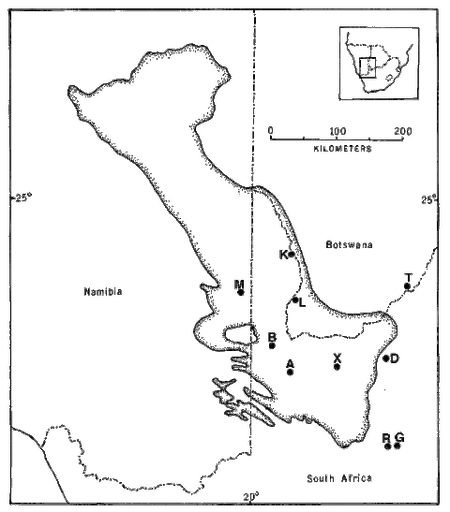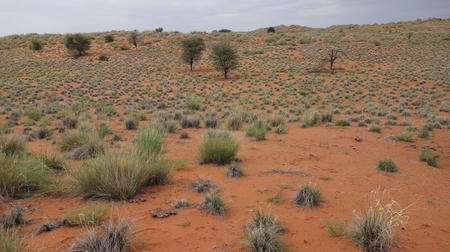Kalahari Study Sites
Positions of ten study areas in the Kalahari. The stippled area in the next figure shows the "sandveld" of the Kalahari as delineated by Leistner (1967).

Positions of ten study areas in the Kalahari. Inside the stippled area is the "sandveld" of the Kalahari as delineated by Leistner (1967).
In the southern Kalahari, major physiognomic and vegetational changes take place along an east-west precipitation gradient: the more mesic eastern region consists of flat sandplains with a savanna-like vegetation, whereas stabilized sandridges characterize the drier western "sandveld" or "duneveld." These red sandridges, which average about 10 m in height, generally parallel the direction of prevailing winds; sandridges are frequently as long as a kilometer or even more and support a characteristic grassy dune vegetation. Interdunal flats or "streets" average about 250 m in width, but occasionally may be much more extensive, sometimes as wide as several km, with a vegetation consisting of various grasses, laced with large bushes and scattered small trees. Two common woody shrubs of Kalahari flats are Rhigozum trichotomum and Grewia flava, both of which are vaguely reminiscent of the North American Larrea divaricata. Detailed descriptions of Kalahari vegetation, with photographs, are provided by Leistner (1967). Ten study areas were selected representing the full range of habitats and conditions prevailing across the southern part of the Kalahari (Pianka 1971).
Average annual precipitation on four easternmost sites (designated areas D, G, R, and T) is greater than 200 millimeters, whereas annual rainfall is less than 200 millimeters on six more westerly study sites (areas A, B, K, L, M, and X). The latter six sites all lie within the "dune area" of the southern Kalahari as delineated by Leistner (1967), and all have sandridges or sand dunes. Areas L and K are within the former Kalahari-Gemsbok National Park (now known as the Kgalagadi Transfrontier Park) and thus represent relatively "pristine" Kalahari desert habitat (both areas support lion, leopard, and hyaena, as well as a half dozen different species of antelope).

Typical Kalahari sandveld desert study site (photo of Bloukrans study site taken by Ray Huey in 2008).
Four eastern sites are all on fairly flat terrain, but vary in their vegetation: area G is a chenopod shrub desert with Atriplex semibaccata, area R is a nearly pure Rhigozum flat, whereas area D supports a more diverse mixture of small to large shrubs, including Rhigozum, Grewia, and the thorny bush Acacia mellifera. Area T, in southern Botswana, is a mixed open forest and savanna site with a substantial number of trees (this site was still quite wild at the time of our initial study in 1969-70 with Spotted Hyaena, but with the advent of bore water, it has since become cattle-grazing country); the savanna and forest sections of the T-area can be treated separately as sub-areas. Most Kalahari observations were made during the 1969-70 Austral season, supplemented on a second trip in 1975-76. Most Kalahari specimens are lodged in the Los Angeles County Museum of Natural History but the 1975-76 specimens are lodged in the Museum of Vertebrate Zoology at the University of California at Berkeley. From 11 to 18 species of lizards in five families were found on Kalahari sites. Censuses of Kalahari lizards collected on each of these study sites were compiled.
| Species | A | B | D | G | K | L | M | R | T | X | Totals |
|---|---|---|---|---|---|---|---|---|---|---|---|
| Agama hispida | 37 | 44 | 31 | 37 | 27 | 29 | 1 | 15 | 11 | 67 | 299 |
| Chameleo dilepis | 2 | 2 | |||||||||
| Heliobolus lugubris | 5 | 13 | 13 | 5 | 44 | 2 | 4 | 125 | 21 | 232 | |
| Ichnotropis squamulosa | 5 | 110 | 115 | ||||||||
| Meroles suborbitalis | 160 | 25 | 31 | 72 | 3 | 187 | 4 | 135 | 85 | 702 | |
| Nucras intertexta | 3 | 3 | |||||||||
| Nucras tessellata | 1 | 26 | 12 | 39 | |||||||
| Pedioplanis lineoocellata | 178 | 95 | 123 | 159 | 48 | 69 | 43 | 19 | 140 | 157 | 1031 |
| Pedioplanis namaquensis | 19 | 10 | 80 | 61 | 8 | 34 | 4 45 | 216 | |||
| Trachylepis occidentalis | 32 | 29 | 15 | 19 | 40 | 26 | 2 | 6 | 29 | 5 | 203 |
| Trachylepis spilogaster | 1 | 96 | 222 | 319 | |||||||
| Trachylepis striata | 16 | 128 | 11 | 134 | 66 | 14 | 7 | 83 | 459 | ||
| Trachylepis variegata | 64 | 8 | 3 | 4 | 5 | 3 | 21 | 108 | |||
| Typhlosaurus gariepensis | 22 | 70 | 2 | 6 | 1 | 8 | 109 | ||||
| Typhlosaurus lineatus | 30 | 32 | 10 | 74 | 132 | 26 | 47 | 104 | 30 | 442 | |
| Chondrodactylus angulifer | 66 | 46 | 48 | 49 | 33 | 44 | 26 | 7 | 71 | 10 | 400 |
| Colopus wahlbergi | 6 | 4 | 3 | 7 | 8 | 4 | 4 | 74 | 5 | 115 | |
| Lygodactylus capensis | 18 | 18 | |||||||||
| Pachydactylus bibroni | 32 | 38 | 1 | 1 | 5 | 77 | |||||
| Pachydactylus capensis | 7 | 3 | 34 | 6 | 1 | 14 | 9 | 34 | 1 | 65 | |
| Pachydactylus rugosus | 1 | 3 | 4 | 2 | 2 | 4 | 8 | 24 | |||
| Ptenopus garrulus | 14 | 3 | 83 | 17 | 48 | 6 | 18 | 6 | 182 | 20 | 397 |
| Number of Species | 15 | 18 | 12 | 14 | 14 | 16 | 14 | 12 | 15 | 16 | |
| Totals | 639 | 586 | 367 | 505 | 542 | 690 | 151 | 442 | 923 | 530 | 5376 |
Kalahari lizard species with family and 4-letter species codes.
| Family | Genus species | species | spec_code |
|---|---|---|---|
| Agamidae | Agama hispida | hispida | agam |
| Chamaeleonidae | Chamaeleo dilepis | dilepis | cham |
| Lacertidae | Heliobolus lugubris | lugubris | lugb |
| Lacertidae | Ichnotropis squamulosa | squamulosa | sqam |
| Lacertidae | Meroles suborbitalis | suborbitalis | subo |
| Lacertidae | Nucras tessellata | tessellata | tess |
| Lacertidae | Pedioplanis lineoocellata | lineoocellata | lino |
| Lacertidae | Pedioplanis namaquensis | namaquensis | nama |
| Scincidae | Trachylepis occidentalis | occidentalis | occd |
| Scincidae | Trachylepis spilogaster | spilogaster | spil |
| Scincidae | Trachylepis striata | striata | mstr |
| Scincidae | Trachylepis variegata | variegata | vari |
| Scincidae | Typhlosaurus gariepensis | gariepensis | tgar |
| Scincidae | Typhlosaurus lineatus | lineatus | tlin |
| Gekkonidae | Chondrodactylus angulifer | angulifer | chon |
| Gekkonidae | Colopus wahlbergi | wahlbergi | colo |
| Gekkonidae | Lygodactylus capensis | capensis | lygo |
| Gekkonidae | Pachydactylus bibroni | bibroni | bibr |
| Gekkonidae | Pachydactylus capensis | capensis | capn |
| Gekkonidae | Pachydactylus rugosus | rugosus | rugo |
| Gekkonidae | Ptenopus garrulus | garrulus | pten |
Kalahari Data Sets
Data collected for each Kalahari lizard (N = 5375) in the field were as follows: unique ID number, species identity, sex (if possible), ambient air temperature at chest height in °C, active body temperature in °C, time of collection, date, latitude, longitude, where the lizard was when first sighted, and where it ran to, fresh field measured snout-vent length, fresh tail length and condition, and weight in grams. All of this information has been digitized and converted to mySQL Tables. Later, in the lab, lizards were dissected, stomachs were removed and their sex and reproductive state was determined. Protocols of these raw data sheets, one for five individual lizards, have never been digitized, but were summarized by hand, and need to be entered into electronic format and cross checked. In addition to using the same 20 different prey categories that were used for North American desert lizards, another more detailed Kalahari dietary data set identified termites to species and castes based on 68 prey categories. Snakes were collected and bird lists were assembled (Pianka and Huey 1971).
Data for over 5,000 Kalahari lizards are also summarized in seven CSV files:
Kalahari field notes were scanned and made into pdf files (Link to download pdfs of Field Notes). I thank Ray Huey for invaluable assistance in curating these data.
References
-
Leistner, O. A. 1967. The plant ecology of the southern Kalahari. Botanical Survey of South Africa, Memoirs 38: 1-172.
-
Pianka, E.R. 1971. Lizard species density in the Kalahari desert. Ecology 52: 1024-1029. Download pdf.
-
Pianka, E. R. and R. B. Huey. 1971. Bird species density in the Kalahari and the Australian deserts. Koedoe 14: 123-130. Download pdf.